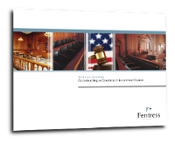A sustained increase in court caseload often means that more judges are needed to hear the cases, which results in a need for more courtrooms. For courts that are already fully-staffed, the only solution is an expansion to the current building or a brand new courthouse – options that don’t relieve the short-term space need and that are often difficult or impossible in jurisdictions with tight budgets.
Instead of tolerating a burdensome caseload and overloading judges and staff, many courts find ways to increase their operational efficiencies. One of these strategies is the use of differentiated case management, which can be a very effective tool to increase courtroom utilization.
What is DCM?
If you are a judge or a clerk of court, you probably know all about differentiated case management. But for many architects and other facility professionals, it is quite likely an unfamiliar term. Differentiated case management – DCM – is a technique that courts use to create an efficient, tight-fitting assignment of cases for judges based on the specific characteristics of each case, much like putting a jigsaw puzzle together. By balancing complex cases that involve more time and resources with simpler cases that require less time and resources, a court manager can better utilize his or her judges and courtrooms.
Working with DCM
When I was a graduate student, I worked in the case assignment section of the county court clerk’s office. The court actively used a DCM program, which improved operational efficiencies throughout the courthouse and positively impacted the courtroom space requirements. A balanced caseload meant an optimal level of courtroom utilization; all of the courtrooms were being utilized as fully and as often as possible and fewer were sitting empty while upcoming dockets piled up.
Here’s how it worked. When a case was filed, the initiating party completed a form that described the case in terms of time needed to complete each stage of the case (such as the time required for the discovery phase). Depending on the complexity of the case, the court clerk’s office assigned it to one of four tracks, from the least to most complex. A less complex case that required only minimal discovery was assigned to the expedited track. Cases in this track had limited pretrial deadlines and trials were set within 90 days of filing. By contrast, the most complex cases were assigned to an extended track, where the trial date was set at over a year away. There were also two other intermediate tracks between the expedited and extended tracks, with varying trial date schedules.
Positive Results
In my job, I witnessed firsthand the efficiencies gained through the court’s use of DCM. The less complex cases were disposed of faster on the expedited track, with many resolved prior to the trial, some dismissed entirely, and others settled through mediation. Resolving these cases quickly was beneficial to everyone involved – the litigants received quick dispositions and the judges who had fewer cases going to trial were able to reserve their time for the cases that most needed their attention. In addition, the clerk’s office had less paperwork and fewer documents to process.
The use of DCM was beneficial for everyone, but the benefits didn’t stop there. The program also improved the court’s image among the public and the legal community. The litigants involved in less complex cases no longer had to wait years to have their cases resolved, while on the criminal side, DCM often reduced the amount of time a defendant spent in pretrial detention because simpler cases were heard and resolved more quickly.
DCM and Courtroom Space Needs
But how does the increased efficiency achieved through the use of DCM impact courthouse space? In the case of my county courthouse, efficient case assignment allowed us to function well with fewer courtrooms than judges. When cases did go to trial, they were assigned to a judge who took one of the available shared courtrooms. Even when we increased judges, we did not need more courtrooms.
Several years ago, I worked with a Maryland court that was considering whether to build an annex to their current courthouse to increase their space and number of courtrooms. My role in the project was to help the court determine how many new courtrooms they needed in the annex and what size each of the courtrooms should be. During one of my planning sessions, a court manager mentioned the DCM program that they had started several years earlier and how successful it had been for them in establishing an effective level of courtroom utilization.
With this knowledge, I was able to shape our analysis of their future workload based upon the “smart” schedule that DCM helped to provide. In addition, the court realized that it did not require any new specially sized courtrooms (such as a larger ceremonial courtroom found in most courthouses), so it ultimately decided to build all of the new courtrooms in the annex the same size so that any judge could use any available courtroom to hear cases. My analysis, combined with their use of DCM, resulted in a need for fewer new courtrooms, a more efficiently sized annex with a high courtroom utilization rate, and a very cost-effective solution for the county.
DCM Goes Beyond Saving Space to Courtroom UtilizationIn my experiences, both past and present, I’ve seen the benefits of the use of DCM. As a court analyst, I would highly recommend it wherever possible as a way to manage caseload and increase efficiencies. But the potential benefits of DCM go beyond workload management. Courts that are facing space and budget shortfalls often feel as though they have limited or no options to relieve overcrowded courtrooms or dockets, which can be intensely frustrating. Identifying and implementing an innovative solution like DCM can help the court both manage cases and utilize courtrooms more effectively.
______________________________________________________________
How to fit a new trial courtroom into your existing courthouse. Click on image to download!




















